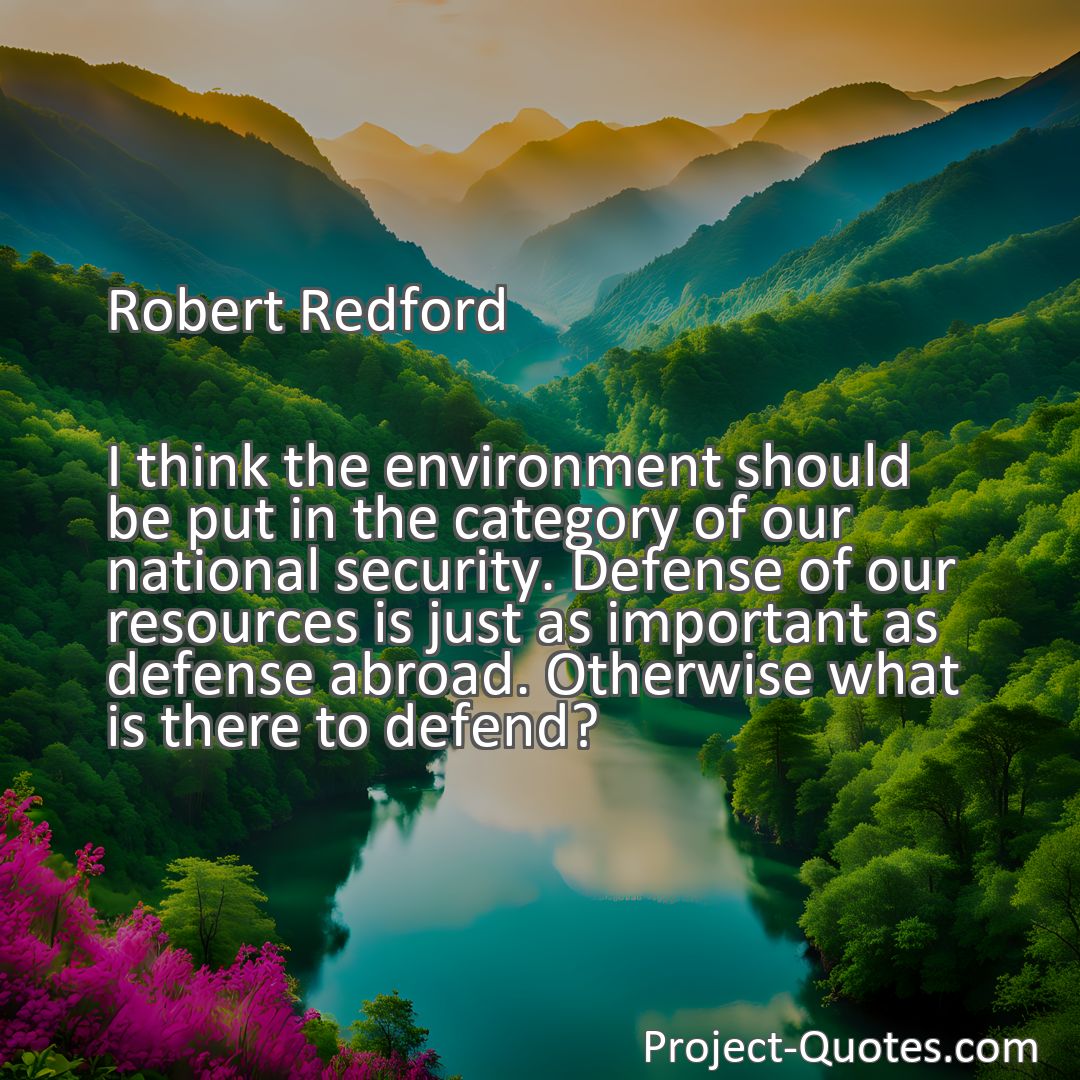I think the environment should be put in the category of our national security. Defense of our resources is just as important as defense abroad. Otherwise what is there to defend?
Robert Redford
“Working Together Towards Common Goals: Protecting the Environment for National Security” emphasizes the need to prioritize environmental preservation as a strategic element of national security. By collaborating and implementing sustainable practices, we can safeguard vital resources and mitigate the threats posed by pollution, climate change, and environmental degradation. Through international cooperation and conservation efforts, we can work towards common goals of protecting our environment and ensuring a safer, more secure future for all.
Table of Contents
- 1 I think the environment should be put in the category of our national security. Defense of our resources is just as important as defense abroad. Otherwise what is there to defend?
- 2 Robert Redford
- 3 Meaning of Quote – I think the environment should be put in the category of our national security. Defense of our resources is just as important as defense abroad. Otherwise what is there to defend?
- 4 Freely Shareable Quote Image
- 5 Related
Meaning of Quote – I think the environment should be put in the category of our national security. Defense of our resources is just as important as defense abroad. Otherwise what is there to defend?
Protecting the Environment: Safeguarding Our National Security
Introduction
Environmental advocate and renowned actor Robert Redford once emphasized the crucial link between our nation’s security and the well-being of our environment. In this thought-provoking quote, Redford implies that protecting our natural resources is as crucial as safeguarding our nation from external threats. By exploring the significance of this statement, we will uncover the interconnectedness between environmental preservation and national security, highlighting how environmental issues can impact various aspects of our lives.
1. Environmental Resilience and National Security
Firstly, let’s delve into the notion of national security. Traditionally, national security has focused primarily on preventing military threats or protecting against terrorism. However, our understanding of security has evolved over time, shifting to encompass a broader range of issues. Environmental resilience is now recognized as a fundamental aspect of national security, as it plays a vital role in ensuring the stability and well-being of a nation. A resilient environment provides essential resources, such as clean air, clean water, and robust ecosystems, which are critical for our society’s functioning and socio-economic development.
2. Threats to National Security Posed by Environmental Degradation
Environmental degradation, including pollution, deforestation, and climate change, poses significant threats to our national security. These issues affect our population’s health, disrupt essential infrastructure, impact military operations, and exacerbate social and political instability.
a) Health Impacts:
Air pollution, often caused by industrial emissions and vehicle exhaust, can lead to respiratory ailments, reducing the workforce’s productivity and putting significant strain on the healthcare system. Water pollution can contaminate water sources, causing outbreaks of waterborne diseases that further strain public health institutions.
b) Infrastructure Vulnerability:
Extreme weather events, intensified by climate change, can damage critical infrastructure, including power grids, transportation systems, and communication networks. These disruptions can lead to economic losses, hamper emergency response efforts, and leave communities vulnerable.
c) Military Preparedness:
Climate change-induced extreme weather events, rising sea levels, and changing landscapes can directly impact military bases and installations, affecting readiness and limiting operational capabilities. Additionally, potential conflicts over scarce resources, such as water or arable land, can strain relationships between nations, increasing the probability of military conflicts.
d) Social and Political Instability:
Environmental degradation can also exacerbate existing social and political tensions, leading to instability and even conflicts. Scarce resources, forced migration due to environmental disasters, and competition over limited resources can result in societal upheavals, political instability, and regional tensions.
3. Protecting the Environment: A Key Pillar of National Security
Recognizing the intertwined relationship between environmental preservation and national security, it becomes imperative to prioritize environmental protection as a strategic element of our security agenda. By investing in sustainable practices and policies, we can promote a safer, more secure future.
a) Conservation and Resource Management:
Implementing conservation measures and sustainable resource management practices can curb environmental degradation and ensure the long-term availability of vital resources. Conserving water, protecting forests, and promoting renewable energy sources are central to maintaining environmental balance, thereby reducing vulnerability to depletion and scarcity.
b) Climate Change Mitigation and Adaptation:
Addressing climate change requires both mitigation efforts (reducing greenhouse gas emissions) and adaptation measures and adaptation measures (adjusting to the changing climate). By transitioning to cleaner technologies, promoting energy efficiency, and investing in climate-resilient infrastructure, we can mitigate the impacts of climate change and enhance our overall security.
c) International Cooperation:
The environmental challenges we face require global collaboration. Engaging in forums and agreements, such as the Paris Agreement, fosters cooperation and knowledge-sharing, enabling nations to work together towards common goals. Collaboration promotes stability by addressing the root causes of environmental issues and fostering trust and harmony among nations.
Conclusion
In conclusion, Robert Redford’s insightful quote reminds us of the inseparable connection between protecting the environment and ensuring our national security. Environmental preservation should be viewed as an essential component of our security agenda, as it directly impacts our health, infrastructure, military capabilities, and societal stability. By acknowledging and addressing the threats posed by environmental degradation, we can fortify our nation’s resilience, thereby enhancing our security and fostering a sustainable future for generations to come.
I hope this quote inspired image brings you hope and peace. Share it with someone who needs it today!


